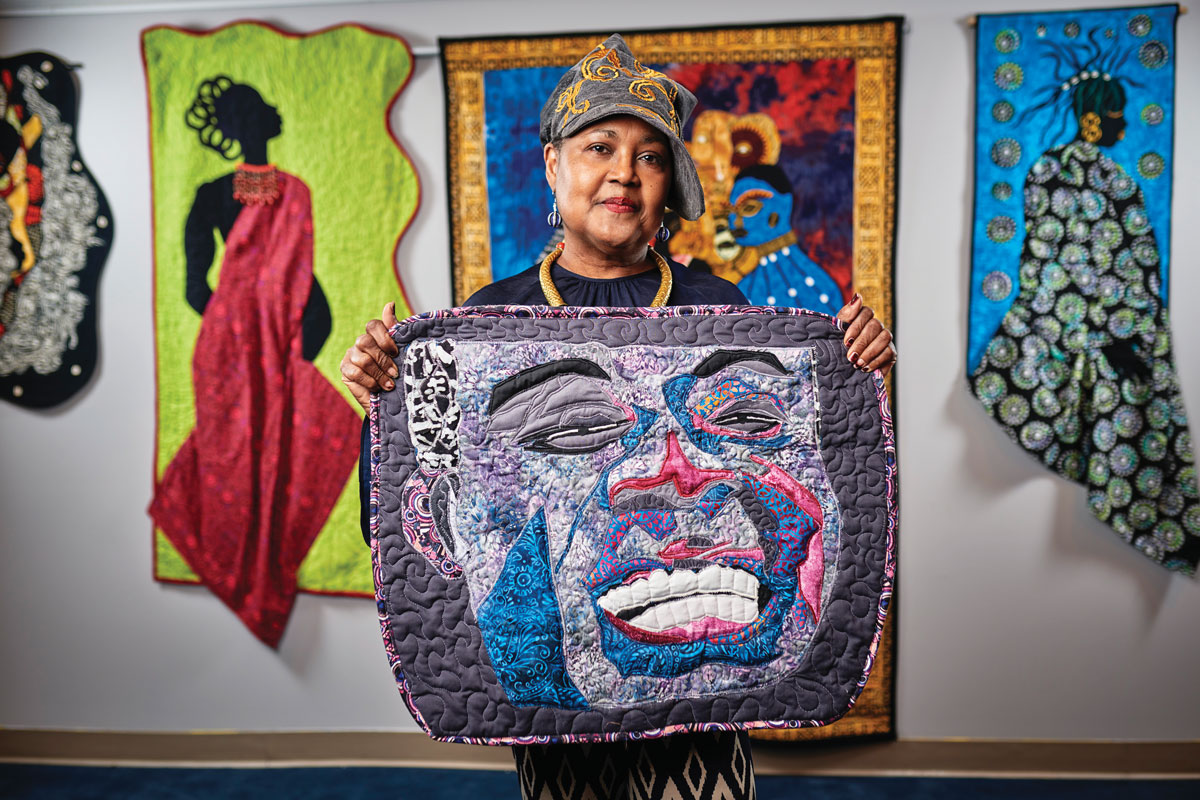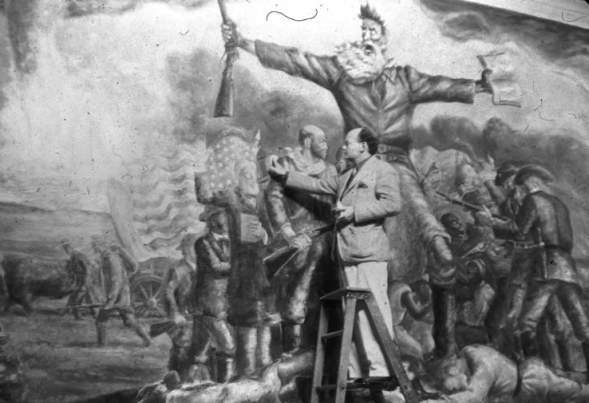
An award-winning Kansas quilt artist answers her grandfather’s challenging question with every stitch
As a child, narrative quilt artist Marla A. Jackson delighted in fabric and color and artistic expression, but most of the sewing she did early on was not for pleasure. Sewing was a punishment her mother imposed upon her, Jackson says at her African American Quilt Museum and Textile Academy in Lawrence.
“Mother taught all eight of her children to sew, but I had to sit and sew more than all the others. I was a little girl with a lot of opinions in me. I did a lot of sewing and had a lot of experience with Lifebuoy soap, washing out my mouth.”
At 67 years of age and struggling with lupus, Jackson is both fierce and delightful, sweet and savory. To hear the stories of her childhood spent near Detroit in the Royal Oak Township—a community, Jackson says, where there was actually a fence between the black and white sides of town—is to understand and admire this African American artist, grandmother, mentor and advocate. The quilts that line a large room in the Quilt Museum each have a story to tell for those with the courage and curiosity sufficient to linger. Many of the visual narratives illustrate disturbing moments in our nation’s history. Jackson and other African American artists who set the scenes to life evoke a range of emotions, from despair and pain to heroic strength, hope and goodwill.
Many of the works in the museum, established in 2012 and open now by appointment, explore the Underground Railroad and struggles for freedom in the lives of African Americans including Harriet Tubman, the First Kansas Colored Volunteer Infantry and Maria Rodgers Martin, an enslaved seamstress.
And while these quilts embody the history of a community, they are also a product of Jackson’s personal experience and family heritage.
Jackson describes her grandfather Crandall Otis Eaton Sr. as a union activist, a Ford Motor Company employee who worked to get Black teachers' tenure. Jackson’s paternal grandfather, Rufus James Crum Sr., was also a Ford worker and the grandson of a slave. He focused on instilling proud freedom in future generations.
“Every Saturday morning he’d drink his coffee from a china cup inlaid with gold,” Jackson says. “And every week, he’d line up all us kids and have us answer his question, ‘Who are you?’
“We’d say our names, one by one, and then repeat the phrase Granddaddy wanted to hear. Every week, I’d say it: ‘I am Marla Crum. I am a proud Negro.’”

That credo served Marla well when she was sent by her fourth-grade teacher to sit on a dunce stool in a corner of her classroom. “I climbed down off that stool and marched to the principal’s office. I requested an appointment with him,” Jackson says.
When the appointment came, Jackson dressed in her best outfit with a mother-of-pearl brooch and the well-shined penny loafers her mother insisted her children wear. “We did not wear welfare shoes,” Jackson says. She entered the principal’s office at the appointed hour, carrying her book bag as though it was a briefcase. She shut the door behind her, telling the principal that this was a private matter.
“I knew I should not be sitting on the dunce chair. Why should a teacher penalize a student who carries themselves with respect?”
In the course of the meeting, Marla let the principal know she was struggling in her classwork. When she’d try to write, “the words just get tangled up on the paper.” She wanted to do good work, and, more than anything, she wanted to be a safety girl, a crossing guard. It was soon discovered that Marla’s struggles were due to poor eyesight. She became a safety girl—and she also got glasses and a desk at the front of the classroom.
The steely backbone Jackson displayed as a child is still evident. When asked why she became a quilter, she answers simply, “I chose to.”
Her quilts tell stories in vibrant colors and surprising textures. They evoke grief, laughter and sometimes pain, honoring events that should never grow cold in our memories.
One of Jackson’s quilts illustrates the bloody raid on the anti-slavery stronghold of Lawrence by a group of Confederate guerrillas in August 1863. Another ice-dyed blue and black quilt with leather figures of murdered participants in the Civil War–era Battle of Lecompton has “Black Lives Matter” embroidered across the top.
The Quilt Museum is listed as a site on the National Park Service’s “Network to Freedom,” honoring the history of the Underground Railroad. Jackson received a Phoenix Award from the Lawrence Cultural Arts Commission in 2016. She completed a term as artist-in-residence for Brown v. Board of Education National Historic Site in Topeka and has a quilt, “Angelic Watch,” in the permanent collection of the Smithsonian Institute’s Anacostia Community Museum in Washington, D.C.
"People look at my art and say, ‘This is not how a quilt is supposed to be.’ But I am an art quilter. I never know what I’m going to create. I stand before the fabric and I start cutting.
“I always want to be inspiring others and reaching back to help someone. I have to do that. I can’t forget who helped me and inspired me.”
Ways to Stay Connected
More Art Stories You'll Enjoy
View ALlFrom the Archives: Remembering John Steuart Curry
Jan 15, 2024Editor's Note: This article was originally published in the winter of 1992 by Don Lambert… Read More
A Paper Moon Pilgrimage
May 19, 2023Photography by Jessi Jacobs Celebrate 50 years of this classic Hollywood film by following the… Read More
Test Your Lumberjack skills with Axe-Throwing
Mar 30, 2023Photography by David Mayes It’s a family outing, date-night fun, stress-reliever and more… Read More
‘Part of the Legacy that Shapes Who We are’
Mar 24, 2023Photography by Carter Gaskins Oscar-winning filmmaker Kevin Willmott talks about his life in Kansas… Read More
Mid-Century Woodworking
Mar 23, 2023Zack Schaffer exudes midwestern modesty. He ranches by day, running several hundred head of cattle… Read More









